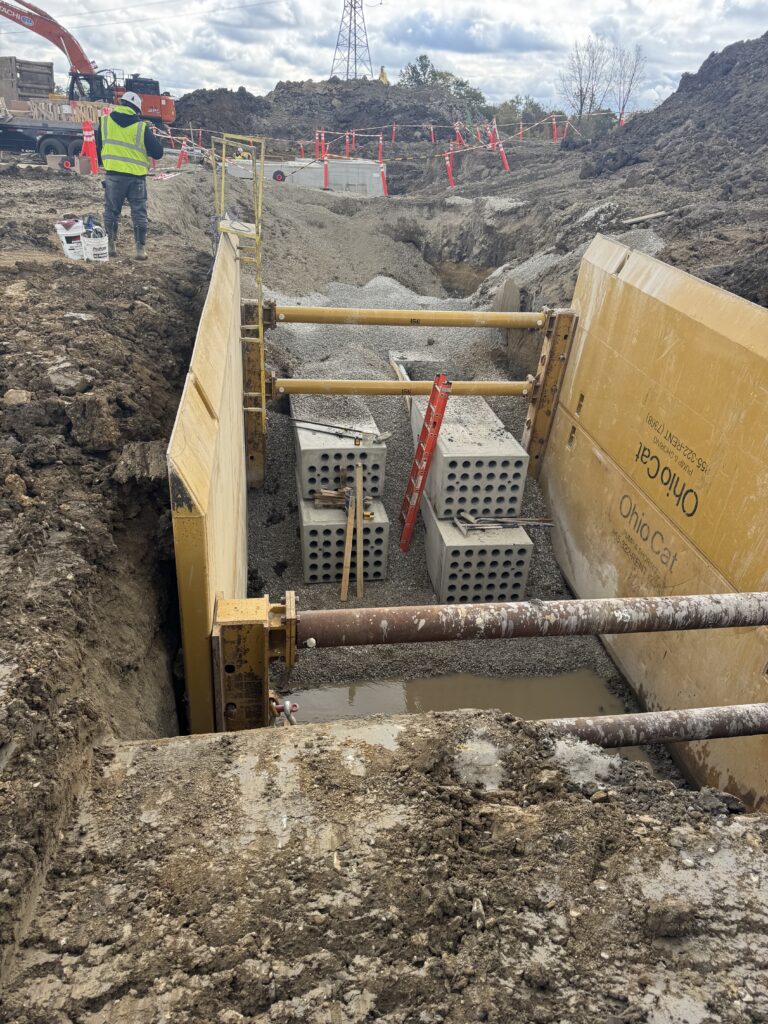Every safety manager knows the rule: the safest trench is the one that’s closed. But on a traditional cast-in-place duct bank, closing it quickly isn’t possible. You’ve got a crew of ten or more down there — electricians, laborers, finishers — working shoulder-to-shoulder around rebar, conduit, and formwork. Concrete trucks back up to the edge. Spotters shout over equipment noise. Everyone’s waiting on one another.
That’s the work environment most of the industry still accepts. DBO decided it could be better.
The Traditional Setup: Too Many Hands, Too Little Space
A cast-in-place duct bank turns into a bottleneck underground.
Typical field picture:
- 10–15 people in the trench — electricians gluing and aligning conduit, laborers tying rebar cages, foremen checking grade.
- Crews spend multiple days in the same open trench waiting on inspections, pours, and curing.
- Form boards, rebar wire, and heavy conduit create constant trip and pinch hazards.
- Shoring or trench boxes limit room to move.
It’s controlled chaos. And even when everyone does everything right, it’s still high exposure. Every extra hour spent below grade multiplies risk — cave-ins, struck-bys, and contact injuries.
The DBO Setup: Controlled, Mechanical, and Safe
Our process reduces that trench exposure by design.
A DBO duct bank install typically involves:
- 1 operator and 1–2 laborers.
- All alignment handled mechanically through guided dowel pins — no hands between sections.
- All work performed from the surface.
The operator lowers the section to within 18 inches of target — no precision landing needed. The dowel pins engage automatically with the previous section’s shear key, aligning the modules perfectly. Crews never reach between sections, never handle conduit alignment, and never need to enter the trench to tie anything.
The Dowel Pin Difference
Traditional precast and cast-in-place systems still rely on manual alignment. Workers have to climb down, adjust conduit by hand, or guide the set with pry bars and signals.
DBO’s guided dowel-pin system changes that.
- Hands-free alignment: no pinch points between modules.
- Accurate placement: pins lock the joint automatically, keeping conduits continuous and square.
- Faster setting: an operator can lower and seat a 10-ft section in 10–15 minutes on day one — and under 5 minutes once trained.
It’s safer because it’s mechanical, not manual.
Quantifying the Safety Impact
Traditional method:
- 10–15 workers in trench, exposed for 3–5 days per run.
- Rebar, wire, wet concrete, and equipment traffic all within the same confined zone.
DBO method:
- 2–3 people total — typically no more than 1 operator + 1 laborer near the trench.
- Sections set and sealed from the surface.
- 80% fewer workers in the hazard zone.
- Trench open less than one full shift before backfill.
Same run. Same scope. A fraction of the exposure. When you combine mechanical placement with same-day backfill, total time spent in the hazard area drops by up to 90%.
Real-World Safety Gains
On recent industrial and data center projects, GCs reported:
- Zero in-trench work injuries during DBO installations.
- No trench-entry permits required for duct bank setting.
- Average open-trench duration: under 8 hours from dig to backfill.
By comparison, field-built duct banks stayed open for 3–5 days, requiring shoring checks, confined-space permits, and safety watch rotation.
Why It Matters
Every hour a trench stays open is an hour of risk. DBO’s precast process replaces field improvisation with engineered control:
- Guided dowel pins replace hand alignment.
- Surface installation replaces trench entry.
- Controlled sequencing replaces stacked trades.
- Same-day backfill replaces multi-day exposure.
You don’t mitigate the risk after it happens — you eliminate it before it starts.
The New Standard for Underground Safety
Safety doesn’t come from another checklist. It comes from building the job differently. DBO’s duct banks let contractors close trenches faster, keep crews above grade, and maintain production without compromise. That’s why general contractors who’ve worked both ways don’t go back.Less time in the hole. Less chance for something to go wrong. That’s how modern underground work should be done.



